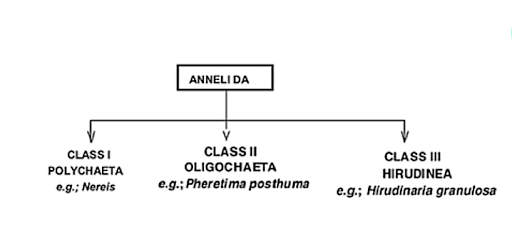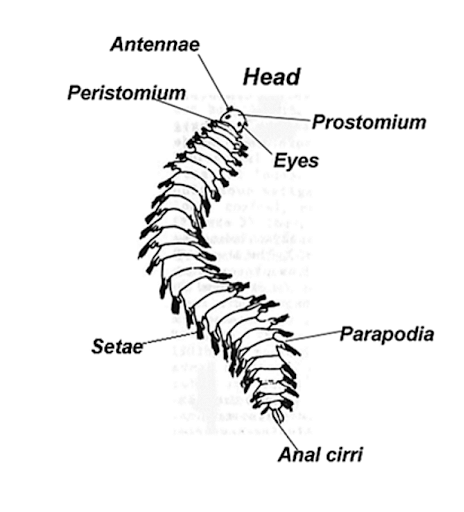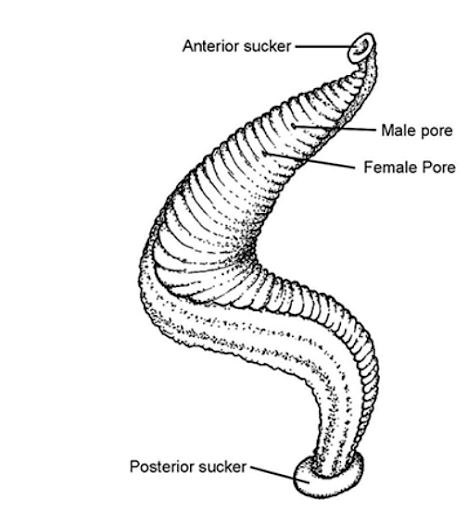Phylum Annelida (Annelids) are triploblastic, animals with fragmented bodies also known as segmented worms. With an expected 22,000 species, the phylum is morphologically fluctuated and isolated into four significant gatherings. The Phylum Annelida has a wide range of body shapes. Annelids live in terrestrial, marine, and freshwater settings, although the presence of water or humidity in terrestrial areas is critical to their existence. Earthworms, polychaete worms, and leeches are members of the Phylum Annelida.
| Table of Content |
Meaning of Annelida
Annelida is a phylum formed from the Latin word annellus, which means "little ring." Because they grow a protostome in embryonic stages, annelids are sometimes known as "segmented worms." They may be found in a variety of habitats, including marine, terrestrial, and freshwater environments. Earthworms, leeches, and Polychaete worms are examples of annelids.
Annelids have highly-developed neural and digestive systems, as well as sexual dimorphism in their reproductive methods. Annelids are invertebrate creatures with bilateral symmetry. They are triploblastic and coelomate. The greatest distinctive aspect of annelids is their segmented bodies.
Characteristics of Annelida
The length of Annelida species ranges from less than 1 millimetre to more than 3 metres. Annelids are all bilaterally symmetrical, with elongated cylindrical bodies separated both outwardly and internally by a regular, linear succession of segments.
Annelida's distinguishing characteristics include:
-
Metamerism
Annelids have three distinct body sections. The majority of the body is made up of repetitive units known as segments. Each segment is separated from the adjoining segments by septa and has a fluid-filled chamber within it known as a coelom.
In annelids, segments form progressively and are created throughout development from growth zones placed at the rear end of the body, hence the youngest segment in the annelid's body is always the most posterior. The only non-segmental components of the annelid body are the head and the terminal post-segmental section known as the pygidium. The head is made up of two parts: the prostomium and the peristomium. Annelids have the incredible ability to regenerate segments that have been torn down into fragments, a process known as regeneration.
-
Chaetae
Chaetae, also known as setae, are bundles of chitinous, thin-walled cylinders held together by sclerotized protein and are a distinguishing characteristic of annelids. Chaetae are cuticular structures that form within epidermal follicles and are created by a microvillar border of some invaginated epidermal cells. Chaetae vary greatly in appearance, from long thin filaments to robust multi-pronged hooks.
-
Clitellum
The clitellum is a feature found on the front section of the worm that aids in the transmission of sperm from one worm to another. It also produces a cocoon inside which fertilisation occurs.
Also Read:
Classification of Phylum Annelida
The following Phylum Annelida examples are provided:

Polychaeta
- They are often referred to as clam worms or sandworms.
- They are carnivorous marine nocturnal creatures.
- Polychaeta can be discovered in burrows along the seashore's tidal zones.
- The body of Nereis is separated into three parts: the head, the trunk, and the pygidium.
- They have a similar sort of circulatory system.
- The locomotory organs are the parapodia.
- Fertilization occurs in marine water.

Polychaeta
Oligochaeta
- They have a cylindrical shape, a soft body, and lengthy segmented bodies.
- They dwell in burrows in the dirt.
- Nephridia is the primary excretory organ.
- They have a closed circulatory system.
- They eat and reproduce exclusively at night.

Oligochaeta
Hirudinaria (Leech)
- They are sometimes referred to as Indian cattle leeches.
- They have a triradiate mouth protected by velum.
- They live in freshwater, ponds, lakes, and marshes.
- Hirudinaria are elongated dorsoventrally flattened segmented elongated dorsoventrally flattened elongated dorsoventrally flattened.
- The alimentary canal in leeches is complete.
- They have anterior and posterior suckers to aid in adhesion and movement.
Hirudinaria
Also Read:
Things to Remember
- The phylum Annelida appeared after the roundworms.
- These are segmented worms with far more complex traits like coelomates, which allow them to coordinate digesting.
- They were the first to exhibit segmentation and possessed a closed circulatory system.
- They develop a new excretory system known as nephridia.
- They are much improved over Platyhelminthes and lack several molluscan characteristics.
Sample Questions
Ques: What are the five distinguishing features of the Phylum Annelida? (5 marks)
Ans: They are generally marine, freshwater, and terrestrial in nature, and they are either free-living or parasitic.
- They are creatures that are bilaterally symmetrical, coelomate, and triploblastic.
- The body is split into multiple parts, which are known as metameres. The body's consecutive segments are divided externally by annuli, which are ring-like constrictions.
- They demonstrate genuine Cephalization.
- The major excretory organ that aids in excretion and osmoregulation is the nephridia.
Ques: Give the classification of Annelida. (3 marks)
Ans: Phylum Annelida consists the group of:
Polychaete: have several chaetae per segment (about 12000 species). Have parapodia that act as limbs, as well as chemosensors. The majority are marine species that dwell in freshwater, with only a few exceptions living on land.
Earthworms: are oligochaetes, and they have a sticky pad on the roof of their mouth. The majority are burrowers that eat completely or partially degraded organic materials.
Hirudinea: means "leech-shaped," and the leeches are the most well-known members of the genus. The majority of marine species are parasites that feed on blood, primarily on fish, whereas the majority of freshwater species are predators. They used to crawl like inchworms because they had suckers on both ends of their bodies.
Ques: Mention Annelida's General Characteristics.
Ans: The following are the general characteristics of Annelida:
- Annelids are coelomates and triploblastic creatures.
- They depict the organization's organ system level.
- They have a segmented body and breathe via the skin.
- They have nephridia, which are specialised excretory organs.
- They also have advanced circulatory and digestive systems.
- Annelida gets their food in a variety of ways, including consuming dead plants and animals, as well as microscopic bits of dirt and stones.
Ques: How can earthworms benefit farmers? (2 marks)
Ans: Earthworms are the most helpful and friendly organisms to a farmer. They are burrowing invertebrates that contribute significantly to soil texture and enrichment. Earthworms munch their way through the soil, ploughing it. They digest the soil, as well as decaying leaves and other organic matter. They are continually loosening the top layer of soil by doing so. As a result, water percolation and air penetration are enhanced. The earthworm's droppings help enrich the soil, making it suitable for plant growth.
Ques: You observe a long, brown, bilaterally symmetric creature in your yard on a rainy day. This organism's body is separated into segments that extend from the head to the tail. Based on its characteristics, which phylum will you categorise the organism? What do you believe the organism is? (2 marks)
Ans: The creature belongs to the phylum Annelida since it is long, brown, and bilaterally symmetrical, having a segmented body. The segmented body is the defining feature. Annelids, on the other hand, dwell in damp terrestrial environments. This annelid is an earthworm that lives in damp soils.
Ques: Define the phrase "Chaetae." (2 marks)
Ans: Chaetae are chitinous hair-like extensions that are anchored in the epidermis and protrude from the cuticle found in every segment of Annelida species. Capillaries and spines are the most basic types. Capillaries are the most frequent type of cat, and they are extremely thin and tapered. Spines, which can be curved or straight, are also frequent, although they are thicker and shunted than capillaries.
Ques: What is the connecting link between ANNELIDA - ARTHROPODA? (2 marks)
Ans: The live creatures that share certain characteristics of two separate groups of animals are referred to as linking links. Peripatus is a primitive arthropod with connected paired legs, compound eyes, and tracheas, but it also has annelidan traits such as a worm-like segmented body, a non chitinous cuticle, and segmental nephridia. It connects Annelida and Arthropoda and is regarded as a living fossil, indicating that the animal is biologically significant.





Comments